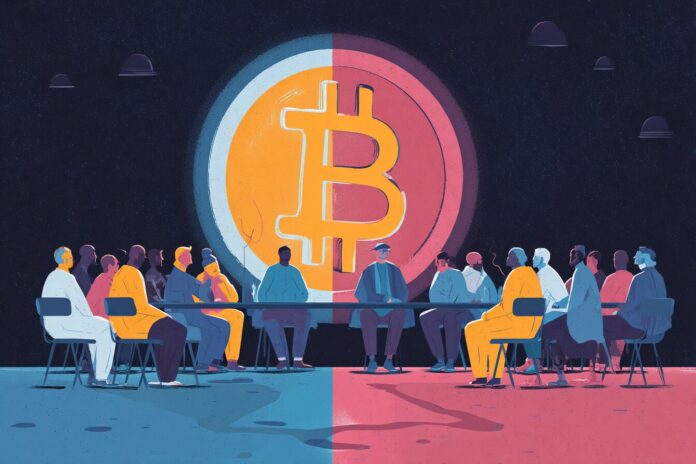Subtitle: The Battle Between Institutional Influence and On-Chain Innovation Defines Bitcoin’s Next Chapter
Bitcoin’s journey is marked by constant evolution and spirited debate, and today a new chapter is unfolding. Most importantly, the emerging clash between Suitcoiners and Ordinals Degens encapsulates a pivotal moment in Bitcoin’s history. Because both groups advocate different paths for Bitcoin—one based on stability and institutional trust, and the other on unfettered creativity and decentralization—they provide a comprehensive lens on the future of digital money.
As institutional investors champion digital gold and regulatory clarity, a vibrant community of on-chain innovators pushes the limits of creativity directly on the Bitcoin network. Therefore, understanding this ideological divide not only sheds light on current debates but also forecasts potential roadmaps for Bitcoin’s evolution. In the following sections, we explore these cultures through detailed insights, historical context from Wikipedia, and the latest commentary from industry experts.
The Suitcoiners: Stability Above All
Suitcoiners are widely associated with Wall Street and traditional finance. Most importantly, they see Bitcoin as a modern equivalent to gold; a safe haven asset for storing value. Because they emphasize stability, scalability, and regulatory compliance, these investors are instrumental in positioning Bitcoin as an asset for mainstream financial portfolios. Their support has been bolstered by recent institutional milestones such as Bitcoin ETFs and the integration of tokenized real-world assets.
In addition, reports indicate that financial institutions are increasingly engaging with blockchain technologies that support real-world assets, including tokenized US Treasurys and private credit. Therefore, Suitcoiners continue to attract significant capital flow, helping Bitcoin meet tightened regulatory standards and ensuring its reputation as a secure investment platform. As highlighted by Cointelegraph, this balance between innovation and regulatory scrutiny is pivotal for Bitcoin’s next leaps into mainstream finance.
Ordinals Degens: Creativity on the Blockchain
On the other hand, the Ordinals Degens represent a spirited collective of technologists, artists, and blockchain enthusiasts. They exploit the versatile Ordinals protocol to inscribe NFT-like data and digital artifacts directly onto Bitcoin’s blockchain. Besides that, this movement champions the idea that Bitcoin is more than simply a store of value—it is also a versatile platform capable of hosting a variety of creative projects.
Most importantly, Ordinals Degens stand as advocates for Bitcoin’s foundational principles of decentralization and openness. By experimenting with digital collectibles, gaming, and creative media, they extend Bitcoin’s utility beyond mere monetary transactions. As showcased in a recent AInvest article, this creative momentum challenges the traditional views held by institutional supporters and invites the broader tech community to contribute to Bitcoin’s evolution.
Why the Divide Matters
The tension between Suitcoiners and Ordinals Degens symbolizes more than a battleground of ideas—it reflects an existential debate on Bitcoin’s core identity. Because each group envisions a different role for Bitcoin in the global financial ecosystem, their clash influences both innovation and market stability. Most importantly, the dynamic interplay between these camps ensures that Bitcoin remains responsive to both the demands of institutional investors and the needs of grassroots innovation.
Because institutional forces drive necessary liquidity and regulatory engagement, and Degens champion permissionless innovation and creative use cases, the friction between these ideologies is essential. Therefore, the current debates over governance and technical upgrades, as discussed in resources like a YouTube exposé, reveal the layers of Bitcoin’s evolving narrative.
Future Scenarios: Convergence or Conflict?
Looking forward, the future of Bitcoin may rest on the ability to synthesize divergent visions. Most industry watchers contend that while short-term trends favor increased institutional adoption and market stabilization, the unique creative impulses of the Ordinals Degens keep the ecosystem dynamic and adaptable. Therefore, the cycle of tension and occasional collaboration between these groups is likely to foster a more resilient and multifaceted network.
Because the technological infrastructure of Bitcoin remains decentralized, even in times of heightened institutional influence, creative experiments ensure that the innovative spirit of the network persists. Besides that, regulatory and technical adaptations might eventually converge, leading to a hybrid future where digital gold meets avant-garde digital artistry. The forecast provided by experts on platforms like Blockchair emphasizes that such a convergence could unlock new growth opportunities for Bitcoin and allied digital assets.
Conclusion: Two Forces, One Destiny
In conclusion, Bitcoin’s future rests on the balanced contributions of both Suitcoiners and Ordinals Degens. The stability promoted by institutional investors provides the necessary framework for Bitcoin’s acceptance as a global store of value. Most importantly, however, the innovative experiments driven by Degens infuse the network with vitality and adaptability, ensuring that Bitcoin remains at the forefront of technological evolution.
Because these two strategies are not mutually exclusive, their ongoing dialogue and occasional cooperation are key to navigating the challenges of the modern financial landscape. Therefore, whether through the lens of regulated stability or creative experimentation, both factions are integral in steering Bitcoin toward a future that upholds its principles of decentralization, resilience, and innovation. For further insights on this multifaceted evolution, readers can explore in-depth analyses from sources such as Cointelegraph and industry experts featured on YouTube.
Ultimately, the ongoing interaction between stability and creativity continues to redefine digital money’s landscape. As technological and financial communities navigate these competing visions, Bitcoin’s core identity is being reshaped in real-time for a new era of global digital finance.
Additional Perspectives and Resources
Beyond the immediate debates, it is crucial to consider Bitcoin’s historical context and its evolution since inception. As detailed on Wikipedia, Bitcoin emerged as a groundbreaking experiment in decentralization in 2009. Most importantly, its journey from a niche digital currency to a mainstream asset reflects a continuous dialogue between conservative finance and disruptive innovation.
Because many advanced projects and experiments now take place on alternative blockchains and through decentralized finance (DeFi) platforms, the lessons learned from Bitcoin’s evolution are critical. In particular, the interaction between institutional strategies and on-chain creativity serves as a blueprint for future digital assets. For comprehensive forecasts and deeper insights, additional analyses can be found at sources like Blockchair.



